OPERATION CHECK 1. CHECK PANEL & STEERING SWITCH
HINT:
- The radio and display receiver assembly panel switches are checked in the following procedure.
- Illustrations may differ from the actual vehicle screen depending on the
device settings and options. Therefore, some detailed areas may not be
exactly the same as on the actual vehicle screen.
- Some of the following functions may also differ from the actual vehicle depending on the device settings and options.
(a) Enter diagnostic mode (See page  ). ).
(b) Select "Function Check/Setting" from the "Service Menu" screen.
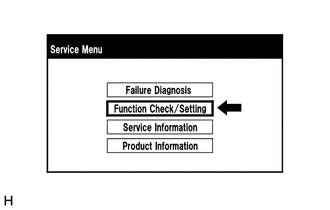 (c) Select "Panel&Steering Switch" from the "Function Check/Setting I" screen.
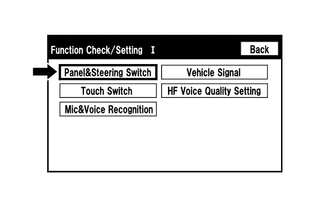 (d) Panel & Steering Switch Check Mode
(1) Operate each switch and check that the number of switches pushed and the switch conditions are correctly displayed.
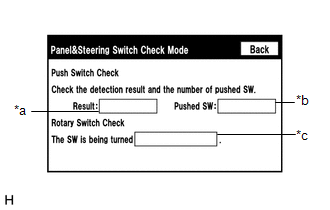 Screen Description Screen Description |
Display | Content | |
*a: Switch condition | "Pushed" is displayed when any switch is pushed | |
*b: Number of pushed switch |
- Number of switches pushed at once is displayed
- If more than 3 switches are pushed at once, "More than 3" is displayed
| | *c: Rotary switch direction |
Direction of rotary switch is displayed |
NOTICE: When
the return switch on the remote operation board is pressed and held for
3 seconds or more, diagnostic mode will be canceled. 2. CHECK TOUCH SWITCH
HINT:
- The touch switches on the screen are checked in the following procedure.
- Illustrations may differ from the actual vehicle screen depending on the
device settings and options. Therefore, some detailed areas may not be
exactly the same as on the actual vehicle screen.
(a) Enter diagnostic mode (See page  ). ).
(b) Select "Function Check/Setting" from the "Service Menu" screen.
 (c) Select "Touch Switch" from the "Function Check/Setting I" screen.
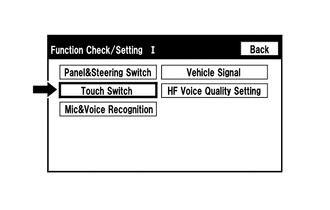 (d) Touch Switch Check
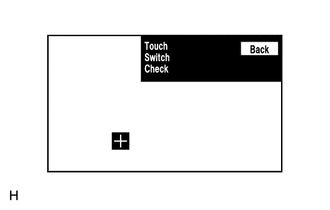 (1) Touch the display anywhere in the open area to perform the check when the "Touch Switch Check" screen is displayed.
HINT:
- A "+" mark is displayed where the display is touched.
- The "+" mark remains on the display even after the finger is removed.
3. CHECK MICROPHONE
HINT:
- The microphone and microphone input level are checked in the following procedure.
- Illustrations may differ from the actual vehicle screen depending on the
device settings and options. Therefore, some detailed areas may not be
exactly the same as on the actual vehicle screen.
(a) Enter diagnostic mode (See page  ). ).
(b) Select "Function Check/Setting" from the "Service Menu" screen.
 (c) Select "Mic&Voice Recognition" from the "Function Check/Setting I" screen.
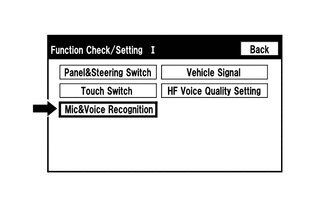 (d) Microphone and Voice Recognition Check
(1) When speaking into the microphone, check that the microphone input level meter changes according to the input level.
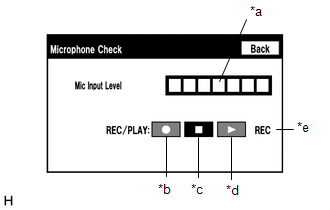 Screen Description Screen Description |
Display | Content | |
*a: Microphone input level meter | Monitors the microphone input level every 0.1 seconds and displays the results in 8 different levels | |
*b: Recording switch* | Starts recording | |
*c: Stop switch* | Stops recording and playing | |
*d: Play switch* | Plays the recorded voice | |
*e: Recording indicator* | Comes on while recording |
4. CHECK VEHICLE SIGNAL
HINT:
- Vehicle signals received by the radio and display receiver assembly are checked in the following procedure.
- Illustrations may differ from the actual vehicle screen depending on the
device settings and options. Therefore, some detailed areas may not be
exactly the same as on the actual vehicle screen.
(a) Enter diagnostic mode (See page  ). ).
(b) Select "Function Check/Setting" from the "Service Menu" screen.
 (c) Select "Vehicle Signal" from the "Function Check/Setting I" screen.
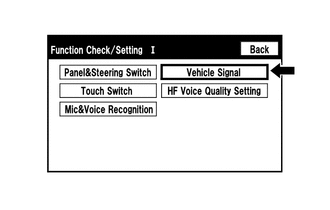 (d) Vehicle Signal Check Mode
(1) When the "Vehicle Signal Check Mode" screen is displayed, check all the vehicle signal conditions.
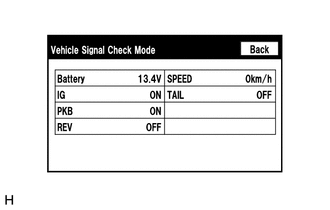 Screen Description Screen Description |
Display | Content | |
Battery | Battery voltage is displayed | |
IG | Ignition switch ON/OFF state is displayed | |
PKB | Parking brake ON/OFF state is displayed | |
REV | Reverse signal ON/OFF state is displayed | |
SPEED | Vehicle speed is displayed in km/h | |
TAIL | Tail signal (light control switch) ON/OFF state is displayed |
HINT:
- Only items sending vehicle signals will be displayed.
- This screen displays vehicle signals received by the radio and display receiver assembly.
- This screen is updated once per second.
5. CHECK HF VOICE QUALITY SETTING
HINT:
- The hands-free voice of a "Bluetooth" compatible phone can be adjusted using the following procedure.
- Illustrations may differ from the actual vehicle screen depending on the
device settings and options. Therefore, some detailed areas may not be
exactly the same as on the actual vehicle screen.
(a) Enter diagnostic mode (See page  ). ).
(b) Select "Function Check/Setting" from the "Service Menu" screen.
 (c) Select "HF Voice Quality Setting" from the "Function Check/Setting I" screen.
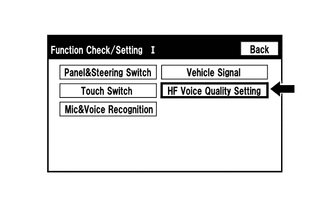 (d) Hands-Free Voice Quality Setting
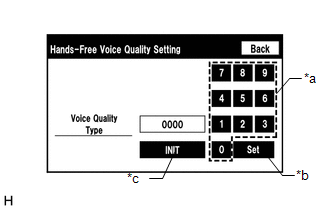 Text in Illustration Text in Illustration |
*a | Numeric keypad | |
*b | Setting button | |
*c | Reset button |
NOTICE: Sound
quality may deteriorate when the receive voice level is changed more
than necessary. For this reason, check that the received voice quality
is still acceptable after changing this setting. (1) If necessary, refer to the table below to adjust the voice quality type with the numeric keypad.
(2) When adjusting the settings, use the number pad on the screen to input the voice quality type according to the table. Settings |
Parameter | Target Phenomenon |
Voice Quality Type | Effect of Changing Voice Quality |
Negative Effect of Changing Voice Quality | |
A (Noise) | The other party hears background noise when listening to your voice |
1000 | The amount of background noise the other party hears when listening to your voice is reduced |
The volume of voice the other party hears when listening to your voice may temporarily drop | |
B (Noise) | The other party hears a lot of background noise when listening to your voice |
2000 | The amount of background noise the other party hears when listening to your voice is sharply reduced |
The volume of voice the other party hears when listening to your voice may temporarily drop | |
C (Noise) | The other party hears weak echoes |
0100 | The amount of echo is reduced (low level) |
Sound quality of the other party deteriorates (low level) | |
D (Noise) | The other party hears strong echoes |
0200 | The amount of echo is reduced (high level) |
Sound quality of the other party deteriorates (high level) | Settings (When Multiple Phenomenon Occurred) |
Parameter | Target Phenomenon |
Voice Quality Type | Effect of Changing Voice Quality |
Negative Effect of Changing Voice Quality | |
A+C | The other party hears background noise and weak echoes when listening to your voice |
1100 |
- The amount of background noise the other party hears when listening to your voice is reduced
- The amount of echo is reduced (low level)
|
- The volume of voice may drop temporarily
- Sound quality of the other party deteriorates (low level)
| | A+D |
The other party hears background noise and strong echoes when listening to your voice |
1200 |
- The amount of background noise the other party hears when listening to your voice is reduced
- The amount of echo is reduced (high level)
|
- The volume of voice may drop temporarily
- Sound quality of the other party deteriorates (high level)
| | B+C |
The other party hears a lot of background noise and weak echoes when listening to your voice |
2100 |
- The amount of background noise the other party hears when listening to your voice is sharply reduced
- The amount of echo is reduced (low level)
|
- The volume of voice may drop temporarily
- Sound quality of the other party deteriorates (low level)
| | B+D |
The other party hears a lot of background noise and strong echoes when listening to your voice |
2200 |
- The amount of background noise the other party hears when listening to your voice is sharply reduced
- The amount of echo is reduced (high level)
|
- The volume of voice may drop temporarily
- Sound quality of the other party deteriorates (high level)
|
HINT:
- The default value is "0000".
- Settings will be applied when the setting button is selected.
- If voice quality type values that are not in the table are input, the
setting will not be applied and a positive effect may not be gained.
- If the quality of phone calls decreases due to the changed settings,
return the settings to "0000" by pressing the "INIT" switch.
6. CHECK SPEAKER
- This function is used when checking the speaker wiring and whether the speakers are functioning properly.
- Illustrations may differ from the actual vehicle screen depending on the
device settings and options. Therefore, some detailed areas may not be
shown exactly the same as on the actual vehicle screen.
(a) Turn audio mode on and play any audio source. HINT: This audio source will be used for the speaker check.
(b) Enter diagnostic mode (See page  ). ).
(c) Select "Failure Diagnosis" from the "Service Menu" screen.
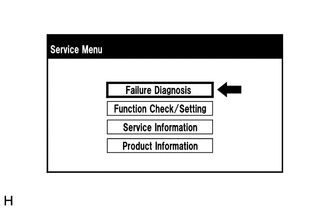 (d) Select "System Check" from the "Failure Diagnosis" screen.
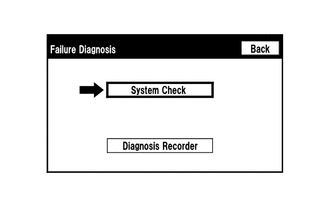 (e) Select "SPCheck ON" from the "System Check Mode" screen.
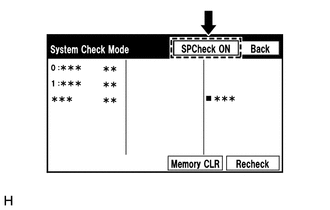 (f) Check the speaker wiring and check that the speakers are functioning properly.
HINT:
- Check that each speaker outputs sound from the selected audio source properly.
- "SPCheck OFF" is displayed during the speaker check.
- Sound can be heard from the speakers around the vehicle in order beginning from a speaker on the front side.
(g) Sound stops when any of the following conditions are met: (1) The "SPCheck OFF" switch is pressed.
(2) The ignition switch is turned off. (3) Diagnostic mode is turned off.
(4) The screen is changed to another screen. (5) Audio mode is turned off.
7. CHECK SOFTWARE ERROR HISTORY HINT: This function is used to check the cause when the radio and display receiver assembly screen is blacked out.
(a) Check software error history. (1) Connect the Techstream to the DLC3.
(2) Turn the ignition switch to ON. (3) Turn the Techstream on.
(4) Enter the following menus: Body Electrical / Navigation System / Utility / Software Error History.
(5) When an item is stored for Software Error History, record it before repairing the radio and display receiver assembly. Software Error History Screen Description |
Error Description | Trigger |
Detail | |
Software Reset | Navi Microcomputer |
Hexadecimal Number | | Audio Microcomputer | |
CAN Microcomputer | |
No Video Signal | Front Monitor | |
Rear Monitor | |
MOST Cold Restart | Always |
HINT:
- Software Error History can store up to 5 history data items. If a new
software error occurs when 5 data items have already been stored, the
oldest data is cleared and the new data is stored.
- If an error that is unsupported by the Techstream occurs, a "-" is displayed for the display items.
(b) Clear software error history. (1) Cleared using the Techstream.
(2) Cleared using the system check mode screen. (3) Cleared using the unit check mode screen.
8. CHECK OPTICAL DISC ERROR HISTORY HINT: This function is used to check the cause when an optical disc error occurs.
(a) Check optical disc error history. (1) Connect the Techstream to the DLC3.
(2) Turn the ignition switch to ON. (3) Turn the Techstream on.
(4) Enter the following menus: Body Electrical / Navigation System / Utility / Optical Disc Error History.
(5) When an item is stored for Optical Disc Error History, record it before proceeding with troubleshooting. Optical Disc Error History Screen Description |
Display | Content | |
Error Type | Displays the type of error | |
Device | Displays the malfunctioning device | |
Date | Displays the date and time that the malfunction occurred | "Error Type" Screen Description |
Error Type | Trigger |
Detail | | Read Error |
When a disc read error occurs |
Proceed to next suspected area shown in Problem Symptoms Table (See page
  ) ) | |
Disc damaged/up side down/dirty | When it is determined that any of the following is the cause of the disc read error:
- The disc cannot be read
- The disc cannot be read because of dirt or scratches
- The disc cannot be read because it is inserted upside down
| | Cannot determine disc type |
An unsuitable disc is inserted | |
DPS error | When an error occurs while decoding MP3/WMA/AAC files | |
Some files are corrupt |
- When MP3/WMA/AAC files cannot be played back because they are unsupported
- Even though the file extensions are MP3, WMA or AAC files cannot be played back because the header information cannot be read
| | Some files cannot be found |
- When a disc without music data is played back
- When there are no playable MP3/WMA/AAC files
| | Copy protection violation |
When a file with copyright protection that cannot be played back is played back | | "Device" Screen Description |
Display | Content | |
DVD-P | Radio and display receiver assembly | |
CD-P | Not available | |
R-Seat DVD-P | Not available |
HINT:
- Optical Disc Error History can store up to 7 history data items. If a
new optical disc error occurs when 7 data items have already been
stored, the oldest data is cleared and the new data is stored.
- If an error that is unsupported by the Techstream occurs, a "-" or blank is displayed for the display items.
(b) Clear optical disc error history. (1) Cleared using the Techstream.
(2) Cleared using the system check mode screen. (3) Cleared using the unit check mode screen.
9. CHECK VIDEO DEVICE CONNECTION CHECK
HINT:
- This function is used to detect disconnection of the video devices.
- In order to inspect the RSE, a disc should be inserted into the radio and display receiver assembly.
(a) Check Video Device Connection Check. (1) Connect the Techstream to the DLC3.
(2) Turn the ignition switch to ON. (3) Turn the Techstream on.
(4) Enter the following menus: Body Electrical / Navigation System / Utility / Video Device Connection Check.
(5) When an item is stored for Video Device Connection Check, record it before proceeding with troubleshooting.
HINT:
- DTCs are stored when errors are detected.
- Depending on the vehicle, some of the items are not displayed on the "Error Detected Image Line (Type)" screen.
Video Device Connection Check Screen Description |
Error Detected Image Line (Type) |
Areas to be Checked | | H/U - > Separate Display (GVIF) |
Not available | | H/U - > Full RSE (GVIF) |
Not available | | RSE - > Seat Back Display RH (GVIF) |
Not available | | RSE - > Seat Back Display LH (GVIF) |
Not available | | Rear Camera - > H/U (NTSC) |
NTSC video signal between the radio and display receiver assembly and television camera assembly | |
IPA/BGM/PVM ECU - > Separate Display (GVIF) |
Not available | | IPA/BGM/PVM ECU - > H/U (NTSC) |
Not available | | IPA/BGM/PVM ECU - > H/U (GVIF) |
Not available | (b) Clear video device connection check.
(1)
When DTCs are cleared using any of the following operations, Video
Device Connection Check will be cleared as well (See page
 ). ).
- Cleared using the Techstream.
- Cleared using the system check mode screen.
- Cleared using the unit check mode screen.
10. CHECK "Bluetooth" CONNECTION HISTORY HINT: This
function is used to check the connection history when the connection
between the radio and display receiver assembly and a "Bluetooth" device
is unstable. (a) Check "Bluetooth" Connection History.
HINT:
- "Bluetooth" Connection History displays data stored in the internal
memory of the ECU, such as the date a "Bluetooth" connection was
attempted and the progress of a "Bluetooth" connection.
- By checking "Bluetooth" Connection History, the date, cause, etc. of a
"Bluetooth" device failing to register or connect can be analyzed.
- "Bluetooth" connection history indicates the estimated cause of a
malfunction, but does not determine it. Therefore, checking "Bluetooth"
Connection History may not improve the problem.
- Performing inspection using the Techstream before recording the "Bluetooth" Connection History may clear the operation history.
(1) Connect the Techstream to the DLC3. (2) Turn the ignition switch to ON.
(3) Turn the Techstream on. (4) Enter the following menus: Body Electrical / Navigation System / Utility / "Bluetooth" Connection History.
(5) When an item is stored for "Bluetooth" Connection History, record it before proceeding with troubleshooting. "Bluetooth" Connection History Screen Description |
Item | Content | |
Occurrence Start Date/ Time | Date and time of "Bluetooth" connection are displayed | |
Occurrence End Date/Time | Date and time of "Bluetooth" disconnection are displayed | |
History Type | Type of "Bluetooth" Connection History is displayed | |
Result | "Bluetooth" connection result is displayed | |
Contents | "Bluetooth" connection status is displayed | |
"Bluetooth" Address | "Bluetooth" device address is displayed | |
Continuance Time | The number of retries when "Bluetooth" connection was performed is displayed | History Type: ACC ON |
Result | Contents |
Detail | Areas to be Checked | |
- | - |
Ignition switch to ACC |
- | History Type: Registration |
Result | Contents |
Detail | Areas to be Checked | |
Success (HFP) | No Error |
"Bluetooth" device was registered as a hands-free device properly |
- | | Success (AVP) |
No Error | "Bluetooth" device was registered as a "Bluetooth" audio device properly |
- | |
Failure | Time Out |
Could not perform "Bluetooth" connection properly |
- Check that the "Bluetooth" device is in the cabin
- Check that the "Bluetooth" device is not connected to another device using the "Bluetooth" connection
- Restart the "Bluetooth" device and operate it again
| |
Authentication Error | Wrong PIN code was input for PIN code verification |
Perform "Bluetooth" device registration again. (Input PIN code correctly) | |
Did not select the confirmation button even though a passkey was displayed |
Perform "Bluetooth" device registration again. (When a passkey is displayed, select the confirmation button) | |
A verification error occurred between the radio and display receiver assembly and "Bluetooth" device |
Restart the radio and display receiver assembly and "Bluetooth" device, and operate them again | |
ACL Link Disconnection | "Bluetooth" connection was disconnected by operating the "Bluetooth" device |
Perform "Bluetooth" device registration again | |
"Bluetooth" connection could not be established due to wave interference around the vehicle |
Check for wave interference and perform "Bluetooth" device registration again | |
"Bluetooth" device was outside the communication area |
Bring the "Bluetooth" device near the radio and display receiver assembly and perform "Bluetooth" device registration again | |
"Bluetooth" setting on the "Bluetooth" device was off |
Change the "Bluetooth" setting to on and perform "Bluetooth" device registration again | |
"Bluetooth" device was off | Turn the "Bluetooth" device on and perform "Bluetooth" device registration again | |
A malfunction occurred in the "Bluetooth" device |
Restart the "Bluetooth" device and operate it again | |
Memory Write Failure | "Bluetooth" device information could not be stored in the radio and display receiver assembly |
Perform "Bluetooth" device registration again | |
Other Error | An error other than above occurred |
After turning the ignition switch off and back to ON again, perform "Bluetooth" device registration again | |
Cancel | No Error |
Registration was suspended by operating the radio and display receiver assembly or "Bluetooth" device |
- | History Type: Connection |
Result | Contents |
Detail | Areas to be Checked |
- Auto Connect Success (HFP)
- Manual Connect Success (HFP)
| No Error |
"Bluetooth" device was connected as a hands-free device properly. |
- |
- Auto Connect Success (AVP)
- Manual Connect Success (AVP)
| No Error |
"Bluetooth" device was connected as a "Bluetooth" audio device properly. |
- |
- Auto Connect Failure (HFP)
- Manual Connect Failure (HFP)
| Time Out |
Could not perform "Bluetooth" connection properly. |
- Check that the "Bluetooth" device is in the cabin.
- Check that the "Bluetooth" device is not connected to another device using the "Bluetooth" connection.
- Restart the "Bluetooth" device and operate it again.
| |
Authentication Error | Verification of authentication key between the radio and display receiver assembly and "Bluetooth" device failed. |
If "Bluetooth" connection failed again even though the "Bluetooth" connection was performed, perform registration again. | |
A verification error occurred between the radio and display receiver assembly and "Bluetooth" device. |
Restart the radio and display receiver assembly and "Bluetooth" device, and operate them again. | |
Page Time Out | Could not find a "Bluetooth" device near the radio and display receiver assembly. |
Bring the "Bluetooth" device near the radio and display receiver assembly and perform "Bluetooth" connection again. | |
"Bluetooth" connection could not be established due to wave interference around the vehicle |
Check for wave interference and perform "Bluetooth" connection again. | |
"Bluetooth" device was outside the communication area. |
Bring the "Bluetooth" device near the radio and display receiver assembly and perform "Bluetooth" connection again. | |
"Bluetooth" setting on the "Bluetooth" device was off. |
Change the "Bluetooth" setting to on and perform "Bluetooth" connection again. | |
"Bluetooth" device was off. | Turn the "Bluetooth" device on and perform "Bluetooth" connection again. | |
A malfunction occurred in the "Bluetooth" device. |
Restart the "Bluetooth" device and operate it again. | |
ACL Link Disconnection | "Bluetooth" connection was disconnected by operating the "Bluetooth" device. |
Perform "Bluetooth" connection again. | |
"Bluetooth" connection could not be established due to wave interference around the vehicle. |
Check for wave interference and perform "Bluetooth" connection again. | |
"Bluetooth" device was outside the communication area. |
Bring the "Bluetooth" device near the radio and display receiver assembly and perform "Bluetooth" connection again. | |
"Bluetooth" setting on the "Bluetooth" device was off. |
Change the "Bluetooth" setting to on and perform "Bluetooth" connection again. | |
"Bluetooth" device was off. | Turn the "Bluetooth" device on and perform "Bluetooth" connection again. | |
A malfunction occurred in the "Bluetooth" device. |
Restart the "Bluetooth" device and operate it again. | |
SDP Error | HFP was disabled on the "Bluetooth" device. |
Enable HFP on the "Bluetooth" device and perform "Bluetooth" connection again. | |
"Bluetooth" device which operation had not been confirmed was used |
Check that the "Bluetooth" device is hands-free compatible and its operation has been confirmed (See page
  ). ). | |
Other Error | An error other than above occurred. |
After turning the ignition switch off and back to ON again, perform "Bluetooth" device registration again. |
- Auto Connect Failure (AVP)
- Manual Connect Failure (AVP)
| Time Out |
Could not perform "Bluetooth" connection properly |
- Check that the "Bluetooth" device is in the cabin
- Check that the "Bluetooth" device is not connected to another device using the "Bluetooth" connection
- Restart the "Bluetooth" device and operate it again
| |
Authentication Error | Verification of authentication key between the radio and display receiver assembly and "Bluetooth" device failed |
If "Bluetooth" connection failed again even though the "Bluetooth" connection was performed, perform registration again | |
A verification error occurred between the radio and display receiver assembly and "Bluetooth" device |
Restart the radio and display receiver assembly and "Bluetooth" device, and operate them again | |
Page Time Out | Could not find a "Bluetooth" device near the radio and display receiver assembly |
Bring the "Bluetooth" device near the radio and display receiver assembly and perform "Bluetooth" connection again | |
"Bluetooth" connection could not be established due to wave interference around the vehicle |
Check for wave interference and perform "Bluetooth" connection again | |
"Bluetooth" device was outside the communication area |
Bring the "Bluetooth" device near the radio and display receiver assembly and perform "Bluetooth" connection again | |
"Bluetooth" setting on the "Bluetooth" device was off |
Change the "Bluetooth" setting to on and perform "Bluetooth" connection again | |
"Bluetooth" device was off | Turn the "Bluetooth" device on and perform "Bluetooth" connection again | |
A malfunction occurred in the "Bluetooth" device |
Restart the "Bluetooth" device and operate it again | |
ACL Link Disconnection | "Bluetooth" connection was disconnected by operating the "Bluetooth" device |
Perform "Bluetooth" connection again | |
"Bluetooth" connection could not be established due to wave interference around the vehicle |
Check for wave interference and perform "Bluetooth" connection again | |
"Bluetooth" device was outside the communication area |
Bring the "Bluetooth" device near the radio and display receiver assembly and perform "Bluetooth" connection again | |
"Bluetooth" setting on the "Bluetooth" device was off |
Change the "Bluetooth" setting to on and perform "Bluetooth" connection again | |
"Bluetooth" device was off | Turn the "Bluetooth" device on and perform "Bluetooth" connection again | |
A malfunction occurred in the "Bluetooth" device |
Restart the "Bluetooth" device and operate it again | |
SDP Error | AVP was disabled on the "Bluetooth" device |
Enable AVP on the "Bluetooth" device and perform "Bluetooth" connection again | |
"Bluetooth" device which operation had not been confirmed was used |
Check that the "Bluetooth" device is "Bluetooth" audio compatible and its operation has been confirmed (See page
  ) ) | |
Other Error | An error other than above occurred |
After turning the ignition switch off and back to ON again, perform "Bluetooth" device registration again | |
Manual Connect Cancel (HFP) |
No Error | Connection was interrupted by operating the radio and display receiver assembly or "Bluetooth" device |
- | | Manual Connect Cancel (AVP) |
No Error | Connection was interrupted by operating the radio and display receiver assembly or "Bluetooth" device |
- | History Type: Disconnection |
Result | Contents |
Detail | Areas to be Checked | |
Disconnection Complete (HFP) |
Link Loss | The "Bluetooth" device was moved outside of the communication area |
Move the "Bluetooth" device into the communication area | |
"Bluetooth" connection was disconnected due to wave interference around the vehicle |
Check for wave interference and perform "Bluetooth" connection again | |
A malfunction occurred in the "Bluetooth" device |
Restart the "Bluetooth" device and operate it again | |
Disconnection from Partner | "Bluetooth" connection was disconnected by operating the "Bluetooth" device |
- | | Disconnection from Self |
"Bluetooth" connection was disconnected by operating the radio and display receiver assembly |
- | | Other Error |
An error other than above occurred | After turning the ignition switch off and back to ON again, perform "Bluetooth" device registration again | |
Disconnection Complete (AVP) |
Link Loss | The "Bluetooth" device was moved outside of the communication area |
Move the "Bluetooth" device into the communication area | |
"Bluetooth" connection was disconnected due to wave interference around the vehicle |
Check for wave interference and perform "Bluetooth" connection again | |
A malfunction occurred in the "Bluetooth" device |
Restart the "Bluetooth" device and operate it again | |
Disconnection from Partner | "Bluetooth" connection was disconnected by operating the "Bluetooth" device |
- | | Disconnection from Self |
"Bluetooth" connection was disconnected by operating the radio and display receiver assembly |
- | | Other Error |
"Bluetooth" connection was disconnected by operating the radio and display receiver assembly |
After turning the ignition switch off and back to ON again, perform "Bluetooth" device registration again | History Type: Send |
Result | Contents |
Detail | Areas to be Checked | |
Success | No Error |
Call was made properly. |
- | |
Failure | Out of Service |
Outside the cellular phone service area |
Move
the vehicle into a cellular phone service area, check that the
"Bluetooth" device is connected to the vehicle and operate the device
again | | Redial Regulation |
Redial of the "Bluetooth" device was restricted and could not make a hands-free call |
Restart the "Bluetooth" device and operate it again | |
Other Error | Could not make a hands-free call due to a "Bluetooth" device malfunction |
Restart the "Bluetooth" device and operate it again | |
Could not make a hands-free call due to a radio and display receiver assembly malfunction |
After turning the ignition switch off and back to ON again, perform "Bluetooth" device registration again | |
Could
not make a hands-free call from the radio and display receiver assembly
because the call status of the "Bluetooth" device was not transmitted
to the radio and display receiver assembly | Restart the "Bluetooth" device and operate it again |
(b) Clear "Bluetooth" connection history. (1)
When DTCs are cleared using any of the following operations,
"Bluetooth" Connection History will be cleared as well (See page
 ). ).
- Cleared using the Techstream.
- Cleared using the system check mode screen.
- Cleared using the unit check mode screen.
11. CONNECTED NAVIGATION RESET PROCEDURE NOTICE: Check if the problem symptom has been repaired after each step.
(a) Duplicate the problem symptom. (b) Check for DTCs and repair the systems for which any DTCs are output (See page
 ). ). (c) Check cellular phone compatibility.
(1) Go to the Toyota website and check if the cellular phone/vehicle is compatible.
(2) If the cellular phone is not compatible, recommend to the customer a compatible cellular phone.
(d) Reset the application on the phone. The procedure varies based on the phone model (ex. iPhone and Android devices).
(e) Reset the phone. NOTICE: Only perform this step if the customer is present and approves.
(1)
Turn off the phone and remove the battery for 15 seconds. For
instructions on how to reset cellular devices, refer to the appropriate
manufacturer's website. (f) Delete all paired devices from the cellular phone.
(1)
The procedure varies based on the phone model. Contact the service
provider or cellular phone manufacturer if assistance is required. (g) Remove the Connected Navigation app from the phone.
NOTICE: Only perform this step if the customer is present and approves.
(1)
The procedure varies based on the phone model. Contact the service
provider or cellular phone manufacturer if assistance is required. (h) Reinstall the Connected Navigation app on the phone. (If removed.)
(1)
The procedure varies based on the phone model. Contact the service
provider or cellular phone manufacturer if assistance is required. (i) Disconnect the cable from the negative (-) battery terminal.
NOTICE: After
turning the ignition switch off, waiting time may be required before
disconnecting the cable from the negative (-) battery terminal.
Therefore, make sure to read the disconnecting the cable from the
negative (-) battery terminal notices before proceeding with work (See
page   ). ). (1) Record all radio station presets.
(2) Disconnect the cable from the negative (-) battery terminal and leave it disconnected for 2 minutes.
(j) Delete all personal data from the head unit. (1) Record all radio station presets.
(2) Delete all personal data from the head unit. NOTICE: Only perform this step if the customer is present and approves.
HINT: Re-installation of applications must be completed before applications will appear on the head unit. | 

 Screen Description
Screen Description 




 Screen Description
Screen Description 

 Screen Description
Screen Description 

 Text in Illustration
Text in Illustration 

